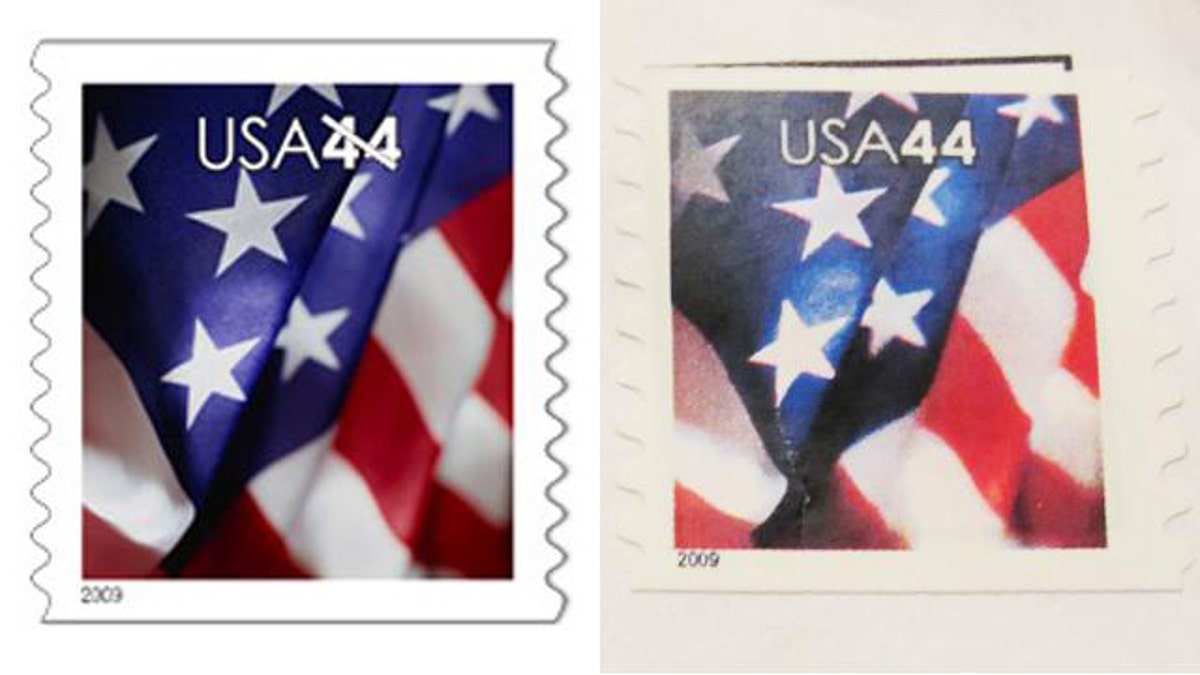
The stamp on the left is an authentic U.S. stamp; the one on the right is a fake. The fake one features a brighter blue color; the blue color on the real stamp is actually darker in hue and more purple (Left: U.S. Post Office; Right: FoxNews.com)
As the U.S. Postal Service grapples with service cuts and massive budget shortfalls, an estimated $134.4 million dollars of its annual revenue is quietly slipping away to counterfeiters and perpetrators of other types of postal fraud.
Counterfeit stamps have been identified as a steady, recurring risk for the U.S. Postal Service, which reported a loss of $8.5 billion in the last fiscal year, and they are one of the 10 biggest threats to Postal Service revenue, according to the 2009 annual report of the U.S. Postal Inspection Service, the law enforcement arm of the Post Office.
Bogus stamps affect the consumers who buy them, too. People who buy stamps online or at local stores are at risk of unknowingly purchasing counterfeits — and then having their mail returned unopened.
You can take my word on this. I'm one of them.
Late last month I bought three stamps from a small neighborhood deli in New York City.
Yes, I know, I should've bought them at the post office. And I usually do — but I was out of stamps, and the post office was closed, and I didn't want my rent, student loans and cable/Internet bills to be late. So I bought three stamps at a local convenience store, stuck them on the envelopes and dropped the bills in the mailbox.
One week later, two of the three came back, each bearing a large sticker that declared:
RETURNED TO SENDER
COUNTERFEIT POSTAGE
A counterfeit detection system at a mail distribution center in the Bronx had rejected two of those stamps, proclaiming them fakes. The other stamp, affixed to my rent check, either slipped through or wasn't counterfeit. You can take my word on this, too: My landlord is not one to let a late payment slide.
The owner of the store where I bought the stamps said I was the first customer ever to return them.
“I’m definitely surprised,” said Noah Mosleh, owner of New Chelsea Gourmet, as he carefully examined the returned envelopes I'd brought back to show him. “Yeah, wow. How about that.”
“I didn’t even know there was such a thing as counterfeit stamps.”
When asked where he’d purchased the stamps, Mosleh, 29, said, “Sometimes guys come around, you buy things like soda, rolls of stamps, things like that....
“We buy the stamps from these guys, you know, to make some money, it’s a business” he said.
His store, like others in New York, sells stamps at marked-up cost. A 44-cent stamp goes for 50 cents.
Postal Inspector Michael Romano, spokesman for the U.S. Postal Inspection Service, said he could not say whether Mosleh's store was the subject of any other similar complaints, citing policy not to comment on ongoing investigations. But he said people need to be aware that there are fake stamps on the market, and they should make sure they’re buying the real deal if they want their mail to go through.
"To avoid being scammed, U.S. Postal Service stamps and products should be purchased either at a U.S. Post Office, USPS.com or a reputable vendor. Customers should be weary about purchasing these products at a price significantly lower than their current value," he said.
Manufacturing or knowingly selling fake postage stamps is a federal crime punishable by fines and/or up to five years in prison. Fortunately for me, it is not a crime to unknowingly purchase fake stamps.
How can you tell if a stamp is counterfeit? Fake 44-cent American Flag stamps are usually a brighter blue, Romano said; the real ones have more of a navy blue or purple hue.
He said anyone with some technological know-how can make fake stamps. Sometimes they come in from overseas — from places like Nigeria where other scams originate — but they’re also being made domestically.
“With all counterfeit instruments we've seen good quality documents and very poor quality ones that are readily apparent. The tools used depends on the person doing the counterfeiting,” Romano said.
“While in some cases a computer and printer are used, other more advanced schemes use more expensive products to attempt to make the stamp appear more authentic.”
And counterfeit stamps aren’t just being sold in corner stores in big cities. Romano said fake stamps can also be bought online.
FoxNews.com found discounted 44-cent stamps for sale through Craigslist in cities across the country: Des Moines, Iowa; Atlanta, Ga.; Minneapolis, Minn.; Norfolk, Va.; and Oklahoma City, among others. Heavily discounted 44-cent stamps were also found for sale on eBay.
It was impossible to ascertain whether the stamps being sold online were counterfeit, but the U.S. postal inspector says one of the biggest indicators that postage is fake is that it’s being sold at discount.
“It's not common for people to be selling USPS postage legitimately at a discounted price," Romano said. "These ads could potentially be scams as well, where they lure you in with an offer that's too good to be true and you get something other than what you were expecting or never get the product at all.”





















